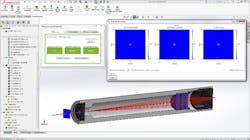Six times you must get the optical product development process right
How to find errors before they’re failures
Designing a new optical product is a risky undertaking. There will be many designs tried—and discarded—in pursuit of the best design. When you’re in a situation that demands a speedy product development cycle, how can you iterate faster and smarter to arrive at the best solution? Technology that enables robust product simulations is critical to facilitating a smooth product development process—especially during six common situations when you can’t afford to get it wrong.
1:When there are hard ship deadlines
Some deadlines may seem arbitrary. But when the success of a product depends on it being on shelves at a certain time of the year, that’s a deadline that can’t be missed.
2: When developing one-off, high-expense items
When engineering teams are designing complex, expensive products, and only one is going to be produced, there’s no chance to tweak the design in the middle of a production run.
3: When a large number of consumers are eagerly awaiting your product
If a company goes to market with a much-anticipated—yet flawed—product, customers will return it, demand their money back, and rethink spending their money on the next launch.
4: When there is downward price pressure
Some companies are under pressure to constantly reduce the price of products every year or quarter—or to launch new products that cost less than their competitors.
5: When investors want reassurances before funding a project
With hundreds of companies vying for investors’ attention, having a rigorously tested virtual prototype can mean the difference between a having a well-funded project and just having another idea.
6: When product safety is of concern
It’s hard to bounce back if your product accidentally hurts people. Beyond the inevitable law suits, your reputation is forever lost. Safety-critical devices, such as in medical or military environments, must get it right the first time.
Identify potential design issues early with virtual prototyping
Most companies are dealing with one or more of the previous six scenarios. So, there is a widespread need for software that puts better validation tools into the hands of engineers to exhaustively model the optomechanical design—and demonstrate that it works every time. By integrating technologies that facilitate robust product simulations, engineering managers will streamline their engineering team’s workflow.
Many software providers that claim to do virtual prototyping don’t offer a complete package: they only provide virtual prototypes of the lens system. When faced with pressures such as heavy consumer anticipation for a product, soliciting investors, or ensuring product safety, there’s simply no way that creating virtual prototypes of the optical and mechanical designs separately is good enough.
Find errors in a virtual prototype—without the time and expense involved in failed physical prototypes.
Effective virtual prototyping is becoming standard in the industry, just as optical design software is now. “It will soon be unthinkable to get a product to market without thorough virtual modeling, including exposure to different light sources, to see how a device behaves,” says Zemax CEO Mark Nicholson. “It seems disruptive now, but it’s not good enough to use the same techniques you have been using for decades. Companies that don’t get on the modern virtual prototyping train will derail.”
Zemax Virtual Prototyping is the solution to management-level concerns of getting optical products to market. By adopting Zemax software across the optical and mechanical design stages of product development, companies can create a virtual prototype of a complete optomechanical assembly, which reduces design iterations, minimizes the number of physical prototypes, speeds time to market, and reduces development costs. Learn how Zemax Virtual Prototyping helps optical product design teams avoid failure by identifying potential design issues early and more quickly.


